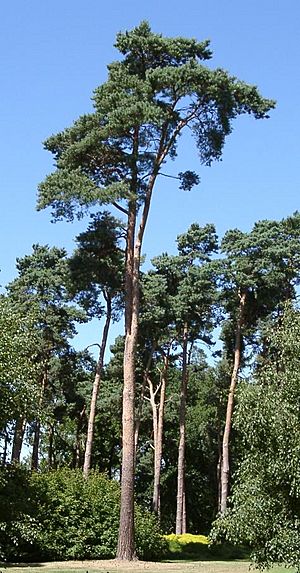Vascular plant facts for kids
The vascular plants, also known as tracheophytes, are a special group of plants. What makes them special? They have tiny tubes inside them! These tubes are like a plant's plumbing system. They carry water, minerals, and the food the plant makes (through photosynthesis) all around the plant.
Think of them as the "higher plants" because they are more complex than plants without these tubes. This group includes many plants you know, like ferns, clubmosses, horsetails, flowering plants (like trees and flowers), and conifers (like pine trees).
Vascular plants are different from other plants in a few key ways:
- They have special tubes called vascular tissues. These tissues help move water and nutrients. Because of these tubes, vascular plants can grow much taller and bigger than plants that don't have them. Plants without these tubes, like mosses, have to stay small because they can't move water very far up.
- Inside these tubes, there are two main types:
* Xylem (pronounced ZY-lem) carries water and minerals from the roots up to the leaves. It's like the plant's upward water pipe. * Phloem (pronounced FLO-em) carries the sugary food the plant makes in its leaves to all other parts of the plant, like the roots and growing tips. It's like the plant's food delivery system.
Quick facts for kids Vascular PlantsTemporal range:
mid Silurian – present |
|
|---|---|
 |
|
| Scientific classification | |
| Kingdom: | |
| Divisions | |
|
|
Contents
Types of Vascular Plants
Vascular plants can be split into two main groups: those that make spores and those that make seeds.
Spore-Bearing Vascular Plants
These plants reproduce using tiny spores instead of seeds. They include:
- Equisetophyta ~ These plants look a bit like miniature pine trees or feathery brushes.
- Lycopodiophyta ~ This group includes clubmosses, spikemosses, and quillworts. They are often small, ground-hugging plants.
- Pteridophyta ~ Ferns are well-known for their beautiful, often feathery leaves called fronds.
Seed-Bearing Vascular Plants
This is a very large and successful group of plants that reproduce using seeds. Seeds protect the young plant and give it a good start. This group is called Spermatophyta. It includes:
- Pinophyta ~ These are cone-bearing trees like pines, spruces, and firs. They usually have needles instead of broad leaves.
- Cycadophyta ~ Cycads are ancient plants that look a bit like palm trees, but they are not related. They have a thick trunk and stiff, fern-like leaves.
- Ginkgophyta ~ The most famous plant in this group is the Ginkgo biloba tree, known for its unique fan-shaped leaves. It's often called a "living fossil."
- Gnetophyta ~ This is a small and unusual group of plants that share some features with both conifers and flowering plants.
- Magnoliophyta ~ These are the flowering plants, also known as angiosperms. This is the largest group of plants, including most trees, shrubs, flowers, and crops. They produce flowers and fruits.
Related Topics
- Non-vascular plant: Learn about plants that don't have the special tubes.
- Embryophyte: Discover more about land plants in general.
Images for kids
See also
 In Spanish: Tracheophyta para niños
In Spanish: Tracheophyta para niños


